

Image of the IonQ Ion Trap Chip. Here is a high-resolution picture of the IonQ ion trap (image credit is Kai Hudek).

The ion qubits are suspended electromagnetically in the center above the thin slot you see in the middle of the bow tie. Control lasers pass across and above the surface of the chip perpendicular to the slot. Yesterday, IonQ announced that they had the most powerful quantum computers in the world. They announced a 79 qubit trapped ion processor and a system with 160 qubit storage. The IonQ Website is here The Q2B conference website is at this link and was organized by QCware. Highlights From the Nextbigfuture Interview with Stewart Allen * IonQ systems are at room temperature * IonQ manipulates ions with magnets and lasers and have software control on mostly FPGA chips * IonQ are like atomic clocks, they do not have time limiting decoherence * IonQ can invent and make any kind of quantum gate.
Email Answer From IonQ About Fully Connected Qubits and Connectivity Tests. The World’s First Practical Quantum Computer May Be Just Five Years Away. You’ve read the headlines: quantum computers are going to cure disease by discovering new pharmaceuticals!
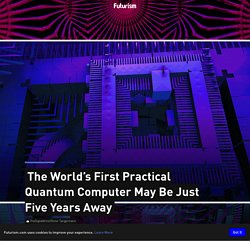
They’re going to pore through all the world’s data and find solutions to problems like poverty and inequality! Alternatively, they might not do any of that. Scientists Perfect Technique To Create Most Dense, Solid-State Memory in History that Could Soon Exceed the Capabilities of Current Hard Drives By 1,000 Times. Economist. How Fast Can Quantum Computers Get? Over the past five decades, standard computer processors have gotten increasingly faster.
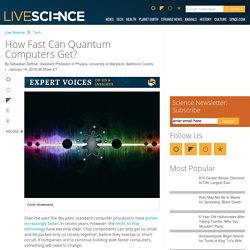
In recent years, however, the limits to that technology have become clear: Chip components can only get so small, and be packed only so closely together, before they overlap or short-circuit. If companies are to continue building ever-faster computers, something will need to change. Gizmodo. New silicon structure opens the gate to quantum computers. In a major step toward making a quantum computer using everyday materials, a team led by researchers at Princeton University has constructed a key piece of silicon hardware capable of controlling quantum behavior between two electrons with extremely high precision.
The study was published Dec. 7 in the journal Science. The team constructed a gate that controls interactions between the electrons in a way that allows them to act as the quantum bits of information, or qubits, necessary for quantum computing. The demonstration of this nearly error-free, two-qubit gate is an important early step in building a more complex quantum computing device from silicon, the same material used in conventional computers and smartphones. Quantum Computing Explained. Now that you have seen what we really meant by superposition, let's try to understand the superposition state of a qubit.
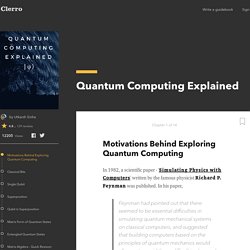
Consider an electron which has a property called 'spin'. It is an intrinsic property of elementary particles, a sort of angular momentum vector like the angular momentum you might have seen in classical mechanics. If you pick a direction of measurement, say the vertical direction, the electron may be spinning about its vertical axis in one of the two directions, i.e., clockwise or anti-clockwise. Thus the spin angular momentum can have one of the two directions, i.e., up or down (ignore the magnitude for now.) Quantum Computing Breakthrough Brings Ultra-Powerful Machines Closer to the Real World. Researchers have invented a device considered crucial for scaling up quantum computing, potentially paving the way for scientific breakthroughs using the ultra-powerful machines on an unprecedented scale.
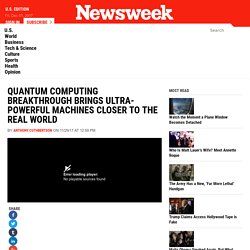
A team from the University of Sydney, Australia, and Microsoft created a component capable of being manufactured in large quantities for quantum computers, which until now have been the exclusive domain of major companies and organizations like NASA, Google and the CIA. The breakthrough, detailed in a paper published in the journal Nature Communications, means a key component in quantum computers—known as a microwave circulator—can be miniaturized by a factor of 1,000. Keep up with this story and more by subscribing now They achieved this by exploiting the properties of topological insulators—a newly discovered phase of matter that earned the scientists who discovered it the 2016 Nobel Prize in Physics. Researchers Claim They Just Invented The "Ultimate" Method for Quantum Computing. In Brief A pair of researchers from the University of Tokyo have developed what they're calling the "ultimate" quantum computing method.

Unlike today's systems, which can currently only handle dozens of qubits, the pair believes their model will be able to process more than a million. Microsoft's Nadella Wants to Help Coders Take a Quantum Leap. Google is Closer Than Ever to a Quantum Computer Breakthrough. In Brief Google is on schedule to produce a 49 qubit chip and achieve quantum supremacy by the end of 2017.
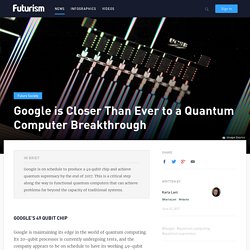
This is a critical step along the way to functional quantum computers that can achieve problems far beyond the capacity of traditional systems. Google’s 49 Qubit Chip Google is maintaining its edge in the world of quantum computing. Its 20-qubit processor is currently undergoing tests, and the company appears to be on schedule to have its working 49-qubit chip ready by the end of 2017 as promised. Traditional computer bits are binary, only existing as either 0 or 1; they’re like light switches that are either on or off. MIT Just Unveiled A Technique to Mass Produce Quantum Computers. In Brief Researchers have found a way to make the creation of qubits simpler and more precise.
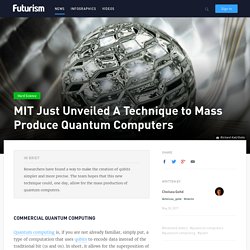
The team hopes that this new technique could, one day, allow for the mass production of quantum computers. Commercial Quantum Computing Quantum computing is, if you are not already familiar, simply put, a type of computation that uses qubits to encode data instead of the traditional bit (1s and 0s). In short, it allows for the superposition of states, which is where data can be in more than one state at a given time. So, while traditional computing is limited to information belonging to only one or another state, quantum computing widens those limitations.
The Age of Quantum Computing Has Arrived. In Brief Technological giants have announced that the launch of quantum computers is imminent.
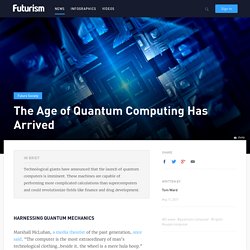
These machines are capable of performing more complicated calculations than supercomputers and could revolutionize fields like finance and drug development. Harnessing Quantum Mechanics Marshall McLuhan, a media theorist of the past generation, once said, “The computer is the most extraordinary of man’s technological clothing…beside it, the wheel is a mere hula hoop.” D-Wave ups its quantum annealing game to 2000 qubits. Universal quantum computers don’t exist, but that hasn’t stopped D-Wave from carving out its own place in the quantum computing market. Today, the 17-year-old company is announcing its forth quantum chip, the 2000Q, doubling the number of qubits on its exiting 1000Q chip. The Burnaby, British Columbia based company’s chips fall under a specific class of quantum computing called quantum annealing. Annealing is useful for a subset of optimization computing problems. Optimization regularly involves hunting for minimums and maximums.
If you remember back to your days of beginner calculus, you might remember a class of problems where you were asked to determine what size squares should be cut from the corners of a sheet of cardboard to produce the largest box. Vern Brownell, CEO of D-Wave explained to TechCrunch that he’s seeing early interest in the 2000Q from companies in financial services and defense. Quantum Computing Is Real, and D-Wave Just Open-Sourced It. Quantum computing is real. But it’s also hard. So hard that only a few developers, usually trained in quantum physics, advanced mathematics, or most likely both, can actually work with the few quantum computers that exist. A Computer That Stores Memories Like Humans Do.
They called it the Hubble Telescope of the mind. This was in 2009, after the announcement that a team of scientists from IBM’s Cognitive Computing group had built what was, at the time, the largest artificial brain ever. It was a cell-by-cell computer simulation of the human visual cortex, large as a cat’s brain. The reference to Hubble, the deep-space telescope, is a nod to the galactic complexity of building a computer with brain-like infrastructure. The cat-sized brain built in 2009 represented 1 billion neurons connected by 10 trillion synapses, according to IBM. Since then, they’ve scaled up dramatically—mapping the neural pathways of a macaque monkey brain, and edging closer to an accurate simulation of the human brain. Simulating an entire, biologically realistic human brain remains an elusive goal with today’s hardware.
Artificial brains are such energy hogs because they can be infinitely precise, meaning they can draw on colossal troves of data to do what they do. There's a New Approach to Quantum Computing: Microwave Signals. In Brief Researchers at Aalto University have demonstrated how microwave signals can be used to code information for quantum computing, possibly creating an approach different from optical systems. In the race to create practical quantum computers, researchers have been focusing on optical systems.
For instance, researchers from MIT recently made an important step towards quantum computing by developing a prototype chip that can trap ions in an electric field, and using built-in optics, direct laser light towards each of them. The First Reprogrammable Quantum Computer Has Been Created. The Beginning of Reprogrammable Quantum Computers While several other teams and companies, including computer technology giant IBM, are in on the race towards quantum computing, all the quantum computers presented thus far can only run one type of operation—which is ironic, seeing as quantum computers can theoretically run more operations than there are atoms in the universe.
Finally, a team of researchers from the University of Maryland say they have developed the first ever fully programmable and reprogrammable quantum computer. It is made up of just five ytterbium atoms standing as quantum bits or qubits of information, which are electrically charged in a magnetic field. “Until now, there hasn’t been any quantum-computing platform that had the capability to program new algorithms into their system. The ions are manipulated using lasers through a process called “optical pumping” in order to set them into the desired quantum energy state.
Baby Steps Towards Something Colossal. This Is the Most Complex Integrated Quantum Circuit Ever Made. Can Dwave Quantum Computers help save finance and prevent future financial meltdowns from flawed models. Dwave Systems and 1QB Information Technologies Inc. (1QBit), a quantum software firm, and financial industry experts today announced the launch of Quantum for Quants (quantumforquants.org), an online community designed specifically for quantitative analysts and other experts focused on complex problems in finance.
Launched at the Global Derivatives Trading and Risk Management conference in Budapest, the online community will allow quantitative finance and quantum computing professionals to share ideas and insights regarding quantum technology and to explore its application to the finance industry. Through this community financial industry experts will also be granted access to quantum computing software tools, simulators, and other resources and expertise to explore the best ways to tackle the most difficult computational problems in finance using entirely new techniques. This is not a unique example.
There are plenty of revered financial techniques that fail to perform as advertised. Bilayer Graphene Quantum Tunneling transistors are ultralow power and could achieve 100 gigahertz operations. IBM Achieves Breakthrough In Storage Memory, 50 Times Faster Than Flash. Google Custom Machine Learning Chip has ten times better performance per watt for machine learning for a seven year advantage. Google began a stealth project several years ago to see what they could accomplish with their own custom accelerators for machine learning applications. The result is called a Tensor Processing Unit (TPU), a custom ASIC they built specifically for machine learning — and tailored for TensorFlow.
Diamond on silicon chips are running at 100 Gigahertz and can also make power chips for directing 10,000 volts. European company ATOS targets exaflop supercomputer by 2020. Atos Chairman and CEO, Thierry Breton claims the Bull sequana is the first exascale-class supercomputer offering a thousand times more performance than current petaflops-scale systems. Computer manufacturer Atos has named its first customer for Bull sequana, a supercomputer design it hopes will reach exaflop levels of performance by 2020. Atos is building the computer for the French Alternative Energies and Atomic Energy Commission (CEA), it said Tuesday. It's an ambitious target for Atos, as it will mean a thousand-fold increase in performance compared to the last machine it built for the CEA, the 1.25-Pflop Tera 100 completed in 2010.
That machine, fast for its day, now languishes in 74th place in the Top500 list. Trapped atoms in an artificial crystal of light is a major leap towards perfect quantum metamaterials free of structural defects. Scientists have devised a way to build a “quantum metamaterial”—an engineered material with exotic properties not found in nature—using ultracold atoms trapped in an artificial crystal composed of light. The theoretical work represents a step toward manipulating atoms to transmit information, perform complex simulations or function as powerful sensors.The research team, led by scientists at the Department of Energy’s Lawrence Berkeley National Laboratory (Berkeley Lab) and UC Berkeley, proposes the use of an accordion-like atomic framework, or “lattice” structure, made with laser light to trap atoms in regularly spaced nanoscale pockets.
Japan will have a 25 petaFLOP supercomputer operating in December 2016. The Joint Center for Advanced High Performance Computing (JCAHPC) in Japan today released the details of its next generation supercomputer – Oakforest-PACs – which will deliver 25 PFLOPS, use Intel’s Xeon Phi (Knights Landing) manycore processors and Omni-Path Architecture, be built by Fujitsu, and be operational in December 2016. When fired up, the Oakforest-PACS will be the fastest supercomputer system in Japan for the moment. Twenty-five PFLOPS would have taken the second spot on the TOP500 last November – ahead of Titan (DoE/Oak Ridge NL, 17.5 PFLOPS) but still short of Tianhe-2 (National Supercomputer Center, Guangzhou, 33.8 PFLOPS).
There has been speculation that China will field two 100 PFLOPS machines this year, perhaps having one benchmarked in time for the June TOP500. China will unveil a 100 petaflop supercomputer next month after investing $500 million to develop domestic chips after US ban on Intel Xeon exports to China. In 2015, the U.S. State Department blocked the further sales of Intel Xeon and Xeon Phi processors to Chinese institutions, most notably the Tianhe-2 supercomputer. The U.S. US Supercomputer Chip ban delayed China's 100 petaFLOP computer by 8 months and contributed to Intel laying off 12,000 employees. In April 2015, the US government refused to let Intel help China update the world's biggest supercomputer. The Tianhe-2 used 80,000 Intel Xeon chips to generate a computational capacity of more than 33 petaflops.
New Quantum Processor Brings Quantum Computing Closer to Reality. Integrated quantum technology in single chips. Neuromorphic supercomputer has 16 million neurons. More than Moore's law strategy for computer industry. Rigetti Computing is a quantum computer startup that emerged from IBM Research. Nanofabrication of a silicon chip with all quantum info processor.
Skyscraper computers chips outperform conventional by 1000 ties. Google Finds Dwave Quantum annealer is 100 million times faster than a classic single core computer and discusses scaling and improving quantum computers. Evolving Scalable Quantum Computers. Dwave Quantum computers are speeding up by 30,000 to 1 million times every 1-2 years. Quantum communications go thin and light. Light travels "infinitely fast" on new zero-index on-chip material.
Australia develops two qubit silicon quantum computer. Intel Invests US$50 Million to Advance Quantum Computing. Quantum Light Harvesting Hints at Entirely New Form of Computing. Here's why DNA could eventually replace hard drives. A little light interaction leaves quantum physicists beaming. Quantum computer firm D-Wave claims massive performance boost. Dwave Systems 1000+ qubit system available, faster than regular computers with 15-600 times speed up over classical solvers. Potentially a very big deal - Dwave 2X 1000-2048 qubit quantum annealing system becoming faster than classical computers. Startup Knowm combines machine learning, quantum computing via memristors. Single DNA molecule could store information for a million years following scientific breakthrough - Science - News - The Independent.
New optical chip lights up the race for quantum computer. MIPT researchers clear the way for fast plasmonic chips. Intel and Micron have new class of non-volatile memory that is 1000 times faster and 10 times denser than NAND Flash memory. Good Vibrations For Computations. Computing at the speed of light: Team takes big step toward much faster computers. Fuzzy and Boolean logic gates based on DNA nanotechnology. IBM Just Cracked One of the Biggest Problems Facing Quantum Computing. Researchers achieve electrical control of quantum bits, paving the way for quantum computers. Entanglement-Based Machine Learning on a Photonic Quantum Computer in principle and if scaled would show exponential speed up. MIT Engineers Beat the Complexity of Deep Parallel Processing. Entanglement on a chip: Breakthrough promises secure communications and faster computers. Scientists create quantum entanglement on a silicon chip. Scientists tame Schrodinger's cat for a new type of quantum computer.
Next Big Future: Nanowire Quantum dot lasers will be components for quantum computers. Quantum Teleportation Reaches Farthest Distance Yet. Replacing wires with light, future computers may operate faster with less energy. This is what the death of Moore’s law looks like: EUV rollout slowed, 450mm wafers halted, and an uncertain path beyond 14nm. Computer First: Silicon Chip Holds Quantum Data. Physicists Discover Particle That's Both Matter and Antimatter. Nvidia Introduces cuDNN, a CUDA-based library for Deep Neural Networks. Quantum Bits Compressed for the First Time. IBM Reveals Incredible New Brain-Inspired Chip. This Scientific Breakthrough May Have Laid The Groundwork For Human TeleportationElite Daily. Scientists Managed to Teleport Data over Three Meters with 100% Accuracy. Quantum Switches Controlled By Single Photons. Bioengineers create circuit board modeled on the human brain. Bioengineers Build Circuit Board Modeled On The Human Brain.
Photovoltaic Solar-panel Windows Could Be Next For Your House. Two Big Steps Toward the Quantum Computer. Quantum computing and new approaches to Artificial Intelligence could get the resources to achieve real breakthroughs in computing.